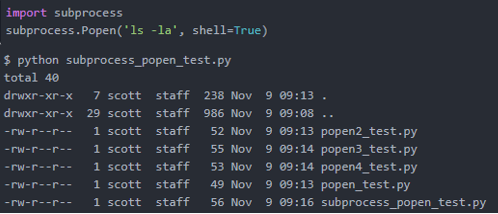

# We still have a '\n', so we strip that out # We decode the output to convert to a string # We run the second subprocess feeding it with the first subprocess' output. P2 = subprocess.Popen(, stdin=subprocess.PIPE, stdout=subprocess.PIPE) # We create the second subprocess, note that we need stdin=PIPE # if we want to get rid of it in a VERY hacky way # Well the result includes an '\n' at the end, P1_out = p1.communicate(input=what_to_feed.encode()) # Note that we encode the data, otherwise we'd get a TypeError


# We immediately run the first subprocess and get the result

P1 = subprocess.Popen(, stdin=subprocess.PIPE, stdout=subprocess.PIPE) # We create the first subprocess, note that we need stdin=PIPE and stdout=PIPE So we can feed the data to grep with stdin in the Python subprocess chain as a variable, and then pass the stdout as a PIPE to the wc process' stdin (in the meantime, get rid of the extra newline character): import subprocess The point of the echo here is to feed the CATCH\nme data to grep.
#PYTHON SUBPROCESS GET OUTPUT FROM STDIN PLUS#
This should normally return the number characters in 'CATCH' plus a newline character, which results in 6. Let's say you want to run the equivalent of echo -n 'CATCH\nme' | grep -i catch | wc -m. That being said, sometimes you might want the output of another process rather than building it up from scratch. I've left the stderr value above deliberately as STDOUT as an example. Output = p.communicate(input='some data'.encode()) P = subprocess.Popen(command, stdin=subprocess.PIPE, stdout=subprocess.PIPE, stderr=subprocess.STDOUT) So, if the streams were not opened explicitly in text mode, then something like below should work: import subprocessĬommand = If streams were opened in text mode, input must be a string. According to the docs, if the streams were opened in text mode, the input should be a string (source is the same page). Similarly, to get anything other than None in the result tuple, you need to give stdout=PIPE and/or stderr=PIPE too.Īlso qed has mentioned in the comments that for Python 3.4 you need to encode the string, meaning you need to pass Bytes to the input rather than a string. Note that if you want to send data to the process’s stdin, you need to create the Popen object with stdin=PIPE. Yet, when feeding the stdin using municate with input, you need to initiate the subprocess with stdin=subprocess.PIPE according to the docs. stderr.read to avoid deadlocks due to any of the other OS pipe buffers filling up and blocking the child process.Īs jro has mentioned, the right way is to use municate. Stdout_data = p.communicate(input='data_to_write') P = Popen(, stdout=PIPE, stdin=PIPE, stderr=PIPE) Process = subprocess.Popen(command,stdout=subprocess.It might be better to use communicate: from subprocess import Popen, PIPE, STDOUT Setting the working directory # cd /tmp/example/a/b/c Process3 = subprocess.Popen(command3,stdin=process2.stdout,stdout=subprocess.PIPE) # Make any lowercase letter in the input uppercase in the output Process2 = subprocess.Popen(command2,stdin=process1.stdout,stdout=subprocess.PIPE) # Find 'hello' in the input and print that match to stdout Process1 = subprocess.Popen(command1,stdout=subprocess.PIPE)
#PYTHON SUBPROCESS GET OUTPUT FROM STDIN MANUAL#
Manual Pipes # echo 'Hello World' | grep -i -o 'hello' -e 's/$/!/' | tr '' '' Print err # NOTE, i'm printing the error, not the output (out,err) = subprocess.Popen(command,stderr=subprocess.PIPE).communicate() Reading Standard Error # grep -i 'what' this_file_is_no_here Reading Standard Output import subprocess Process = subprocess.Popen(command,stdout=subprocess.PIPE,stdin=subprocess.PIPE) (out,err) = subprocess.Popen(command,stdout=subprocess.PIPE).communicate() Specifying Arguments #date '+%Y-%m-%d %H:%M:%S' (out,err) = subprocess.Popen(,stdout=subprocess.PIPE).communicate() Os.chdir(os.path.expanduser('~') + '/.cache/thumbnails') If you need your script to change to a different directory you can use os.chdir which will change the directory for the current process. This is how processes are designed to work. The cd works in that process, but when the process exits it won't affect the current process. Subprocess.Popen("cwm -rdf test.rdf -ntriples > test.nt") Process = subprocess.Popen(bashCommand.split(), stdout=subprocess.PIPE) Subprocess.call("(cd ~/catkin_ws/src & catkin_make)", shell=True)īashCommand = "cwm -rdf test.rdf -ntriples > test.nt" # By default subprocess.call doesn't use a shell to run our commands you so can't shell commands like cd P = subprocess.Popen(filepath, shell=True, stdout = subprocess.PIPE)


 0 kommentar(er)
0 kommentar(er)
